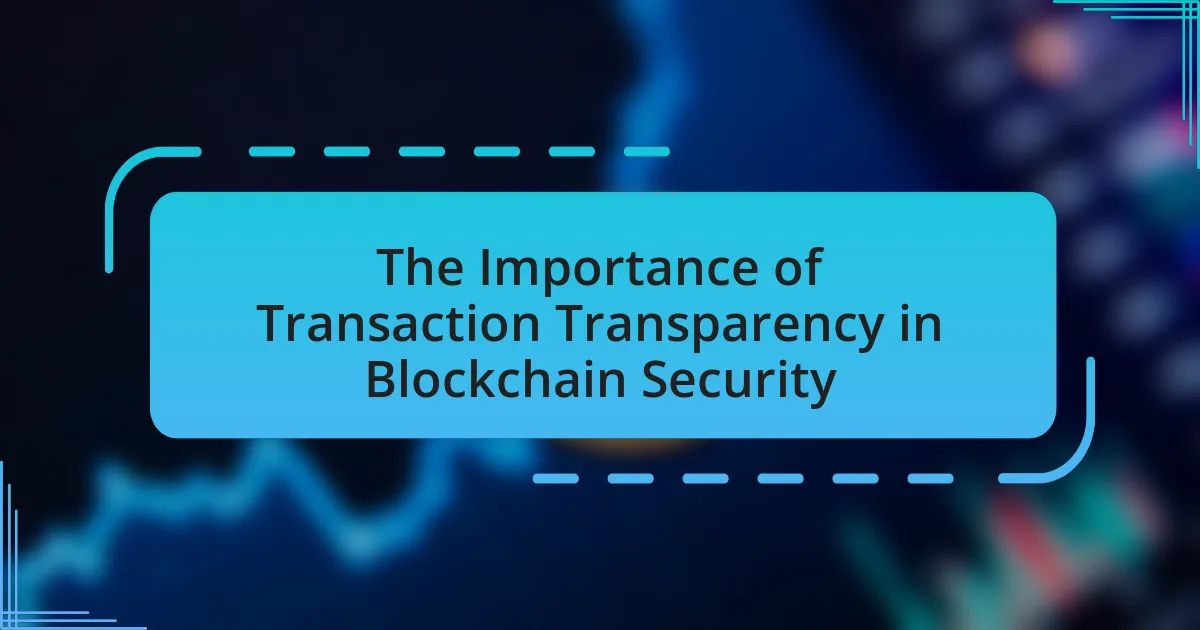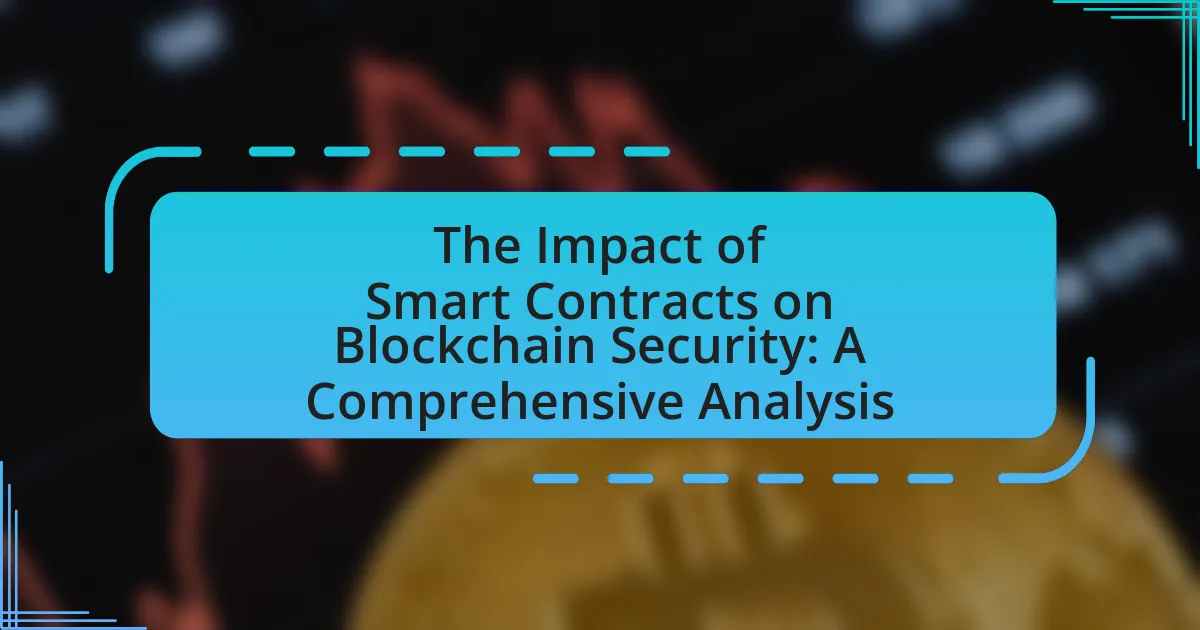Blockchain explorers are essential online tools that enable users to view and analyze blockchain transactions in real-time, playing a vital role in enhancing network security through transparency and traceability. This article outlines the functionality of blockchain explorers, the types of data they provide, and their significance in monitoring network security against common threats such as hacking and fraud. It also discusses best practices for utilizing these tools effectively, including setting alerts for suspicious activities and avoiding common mistakes. Additionally, the article highlights the latest trends in blockchain explorer technology and the impact of advancements in artificial intelligence on security monitoring.
What are Blockchain Explorers and Their Role in Network Security?
Blockchain explorers are online tools that allow users to view and analyze blockchain transactions and data in real-time. They play a crucial role in network security by providing transparency and traceability of transactions, enabling users to verify the legitimacy of activities on the blockchain. By allowing users to track transaction histories, blockchain explorers help identify suspicious activities, such as double spending or fraudulent transactions, thereby enhancing the overall security of the network. Additionally, they facilitate the monitoring of network health and performance, which is essential for maintaining the integrity and security of blockchain systems.
How do Blockchain Explorers function?
Blockchain explorers function as web-based tools that allow users to view and interact with blockchain data. They provide a user-friendly interface to access information such as transaction history, block details, and wallet balances. By indexing blockchain data, explorers enable users to search for specific transactions or addresses, facilitating transparency and traceability within the network. For example, Bitcoin blockchain explorers like Blockchair and Blockchain.com allow users to input a transaction ID or wallet address to retrieve detailed information about that specific entry, demonstrating their role in enhancing user engagement and network monitoring.
What data can be accessed through Blockchain Explorers?
Blockchain explorers provide access to transaction data, block information, and wallet addresses. Users can view transaction histories, including timestamps, amounts, and sender/receiver details. Additionally, explorers display block details such as block height, miner information, and the total number of transactions within each block. This data is essential for monitoring network activity and ensuring transparency in blockchain operations.
How do Blockchain Explorers visualize blockchain data?
Blockchain explorers visualize blockchain data through graphical representations such as charts, graphs, and tables that display transaction histories, block details, and network statistics. These tools aggregate and present data from the blockchain in a user-friendly format, allowing users to track transactions, view block confirmations, and analyze network activity in real-time. For instance, explorers often show the number of transactions per second, the total number of blocks, and the current block height, which helps users understand the blockchain’s performance and security status.
Why is monitoring network security important in blockchain?
Monitoring network security is crucial in blockchain to prevent unauthorized access and ensure the integrity of transactions. Blockchain networks are decentralized and often public, making them susceptible to various cyber threats, including hacking and fraud. By actively monitoring network security, organizations can detect anomalies, respond to potential breaches in real-time, and maintain trust among users. For instance, a report by the Cybersecurity and Infrastructure Security Agency (CISA) highlighted that timely detection of security incidents can significantly reduce the impact of cyberattacks on blockchain systems.
What are the common security threats in blockchain networks?
Common security threats in blockchain networks include 51% attacks, smart contract vulnerabilities, and phishing attacks. A 51% attack occurs when a single entity gains control of more than half of the network’s mining power, allowing them to manipulate transactions and double-spend coins. Smart contract vulnerabilities arise from coding errors or flaws in the contract logic, which can be exploited by attackers to steal funds or disrupt services. Phishing attacks target users through deceptive communications, tricking them into revealing private keys or sensitive information. These threats highlight the importance of robust security measures and continuous monitoring in blockchain environments.
How can Blockchain Explorers help identify these threats?
Blockchain explorers can help identify threats by providing real-time visibility into blockchain transactions and activities. They allow users to track and analyze transaction histories, which can reveal suspicious patterns such as unusual transaction volumes or addresses associated with known malicious activities. For instance, blockchain explorers can highlight transactions linked to blacklisted addresses, enabling users to take proactive measures against potential fraud or theft. Additionally, the transparency of blockchain data allows for the identification of anomalies that may indicate security breaches, thereby enhancing overall network security.
What Best Practices Should Be Followed When Using Blockchain Explorers?
When using blockchain explorers, it is essential to ensure data accuracy by cross-referencing information from multiple sources. This practice helps verify transaction details, such as confirmations and timestamps, which are critical for assessing the legitimacy of transactions. Additionally, users should familiarize themselves with the specific blockchain explorer’s interface and features to maximize its utility, as different explorers may offer unique functionalities like advanced filtering options or historical data analysis. Furthermore, maintaining awareness of potential phishing attempts is crucial; users should only access trusted blockchain explorers to avoid malicious sites that could compromise security. These best practices enhance the reliability and effectiveness of monitoring network security through blockchain explorers.
How can users effectively utilize Blockchain Explorers for security monitoring?
Users can effectively utilize Blockchain Explorers for security monitoring by tracking transaction histories and analyzing wallet activities. By entering specific wallet addresses or transaction IDs into a Blockchain Explorer, users can observe real-time data on transactions, including amounts, timestamps, and associated addresses. This transparency allows users to identify suspicious activities, such as unusual transaction patterns or large transfers that deviate from normal behavior. Additionally, Blockchain Explorers often provide features like alerts for specific transactions or changes in wallet balances, enabling proactive monitoring. The ability to view the entire transaction history of a wallet can also help users verify the legitimacy of funds and detect potential fraud or theft, reinforcing the security of their assets.
What specific features should users look for in a Blockchain Explorer?
Users should look for features such as transaction tracking, block information, address search, and network statistics in a Blockchain Explorer. Transaction tracking allows users to view the status and details of specific transactions, while block information provides insights into the latest blocks added to the blockchain, including timestamps and miner details. Address search enables users to investigate the balance and transaction history associated with specific wallet addresses. Network statistics offer data on overall network health, including hash rate and transaction volume, which are crucial for assessing security and performance. These features collectively enhance the user’s ability to monitor and analyze blockchain activity effectively.
How can users set up alerts for suspicious activities?
Users can set up alerts for suspicious activities by utilizing blockchain explorers that offer notification features. These explorers allow users to create alerts based on specific criteria, such as transaction thresholds, wallet addresses, or unusual patterns in activity. For instance, platforms like Etherscan and Blockchair provide options to set up email or SMS notifications when transactions meet predefined conditions, ensuring users are promptly informed of any potentially malicious actions. This proactive approach enhances security by enabling users to monitor their assets and respond quickly to threats.
What are the common mistakes to avoid when using Blockchain Explorers?
Common mistakes to avoid when using Blockchain Explorers include relying on outdated or inaccurate data, misinterpreting transaction statuses, and overlooking the importance of transaction fees. Relying on outdated data can lead to incorrect conclusions about network activity, as blockchain data is constantly updated. Misinterpreting transaction statuses, such as confusing “pending” with “confirmed,” can result in misunderstandings about the state of transactions. Additionally, overlooking transaction fees can lead to unexpected delays or failures in transaction processing, as fees can vary significantly based on network congestion. These mistakes can hinder effective monitoring of network security and transaction integrity.
How can misinterpretation of data lead to security issues?
Misinterpretation of data can lead to security issues by causing incorrect assessments of vulnerabilities or threats within a network. When data from blockchain explorers is misread, it may result in overlooking suspicious activities or misidentifying legitimate transactions as malicious. For instance, a study by the International Journal of Information Security highlights that inaccurate data analysis can lead to a 30% increase in undetected security breaches. This misinterpretation can compromise the integrity of the network, allowing attackers to exploit perceived weaknesses that were inaccurately assessed.
What practices can help ensure accurate data analysis?
To ensure accurate data analysis, implementing data validation techniques is essential. Data validation involves checking the accuracy and quality of data before it is analyzed, which can include methods such as cross-referencing data sources, using automated validation tools, and establishing clear data entry protocols. According to a study by Redman (2018) in the Journal of Data Quality, organizations that employ rigorous data validation practices experience a 30% reduction in errors during analysis, highlighting the effectiveness of these techniques in enhancing data integrity.
How Can Users Enhance Their Skills in Using Blockchain Explorers?
Users can enhance their skills in using blockchain explorers by actively engaging with the tools through hands-on practice and utilizing educational resources. Regularly exploring different blockchain explorers, such as Etherscan or Blockchair, allows users to familiarize themselves with various features like transaction tracking, wallet monitoring, and block analysis. Additionally, users can improve their understanding by following tutorials, participating in online forums, and reading documentation provided by the explorers, which often include detailed guides and FAQs. Engaging with community discussions on platforms like Reddit or specialized blockchain forums can also provide insights and tips from experienced users, further enhancing their skills.
What resources are available for learning about Blockchain Explorers?
Resources for learning about Blockchain Explorers include online courses, tutorials, and documentation provided by specific blockchain platforms. Websites like Coursera and Udemy offer structured courses that cover the fundamentals of blockchain technology and the use of explorers. Additionally, platforms such as Blockchain.com and Etherscan provide user guides and FAQs that explain how to navigate their explorers effectively. Furthermore, community forums like Reddit and Stack Exchange can be valuable for real-world insights and troubleshooting tips from experienced users.
How can online courses improve understanding of blockchain security?
Online courses can significantly enhance understanding of blockchain security by providing structured, comprehensive content that covers key concepts, protocols, and best practices. These courses often include interactive elements such as quizzes and hands-on projects, which facilitate practical learning and application of theoretical knowledge. For instance, a study by the International Journal of Information Management found that online learning platforms improve knowledge retention by 25-60% compared to traditional methods. Additionally, access to expert instructors and up-to-date resources in online courses ensures learners are informed about the latest security threats and mitigation strategies in the blockchain space.
What role do community forums play in skill enhancement?
Community forums play a crucial role in skill enhancement by providing a platform for knowledge sharing, peer support, and collaborative learning. These forums enable individuals to ask questions, share experiences, and receive feedback from others with varying levels of expertise, which fosters a deeper understanding of complex topics. Research indicates that participation in community forums can lead to improved problem-solving skills and increased confidence in applying new knowledge, as users engage in discussions that challenge their thinking and expand their perspectives.
What are the latest trends in Blockchain Explorer technology?
The latest trends in Blockchain Explorer technology include enhanced user interfaces, integration of advanced analytics, and support for multiple blockchain networks. Enhanced user interfaces improve accessibility and usability, allowing users to navigate complex data more intuitively. Advanced analytics tools provide deeper insights into transaction patterns and network health, enabling better monitoring of security threats. Additionally, the support for multiple blockchain networks allows users to track and analyze data across various platforms, reflecting the growing interoperability in the blockchain ecosystem. These trends are driven by the increasing demand for transparency and security in blockchain transactions.
How are advancements in AI impacting Blockchain Explorers?
Advancements in AI are enhancing the functionality and efficiency of Blockchain Explorers by enabling more sophisticated data analysis and real-time monitoring. AI algorithms can process vast amounts of blockchain data quickly, identifying patterns and anomalies that may indicate security threats or fraudulent activities. For instance, machine learning models can analyze transaction histories to detect unusual behavior, improving the ability to monitor network security effectively. This integration of AI not only streamlines the user experience but also increases the accuracy of insights derived from blockchain data, making it a crucial tool for maintaining the integrity of blockchain networks.
What future developments can enhance network security monitoring?
Future developments that can enhance network security monitoring include the integration of artificial intelligence and machine learning algorithms. These technologies can analyze vast amounts of data in real-time, identifying patterns and anomalies that may indicate security threats. For instance, a study by IBM found that organizations using AI for security monitoring experienced a 27% reduction in security incidents. Additionally, the implementation of blockchain technology can provide immutable logs of network activity, ensuring transparency and traceability, which further strengthens security monitoring efforts.
What practical tips can improve the use of Blockchain Explorers for security monitoring?
To improve the use of Blockchain Explorers for security monitoring, users should regularly track transaction patterns and set alerts for unusual activities. Monitoring transaction patterns helps identify anomalies that may indicate fraudulent behavior or security breaches. Setting alerts for specific thresholds, such as large transactions or rapid transfers, enables timely responses to potential threats. Additionally, utilizing advanced filtering options within Blockchain Explorers can enhance the visibility of relevant transactions, making it easier to focus on suspicious activities. These practices are supported by the fact that proactive monitoring significantly reduces the risk of undetected security incidents in blockchain networks.





